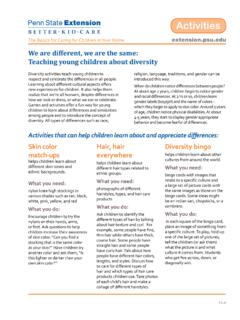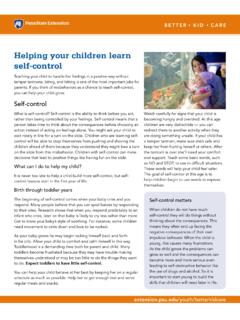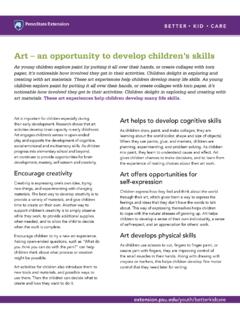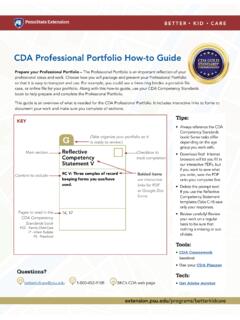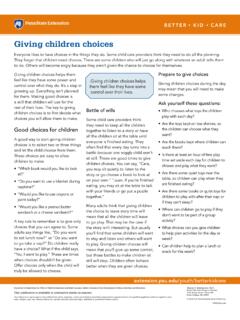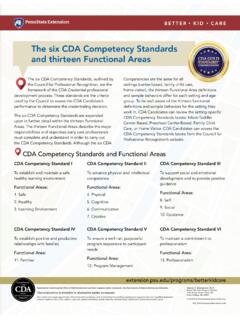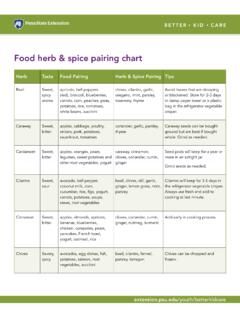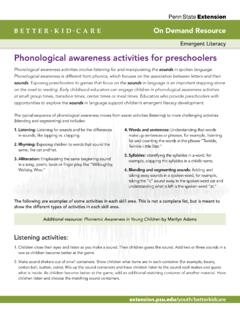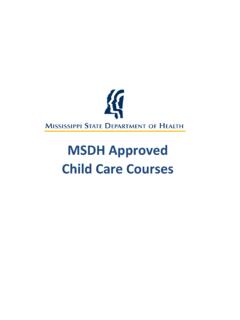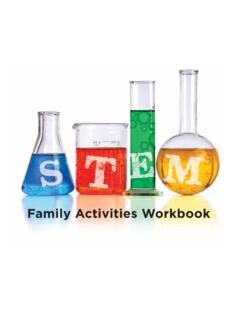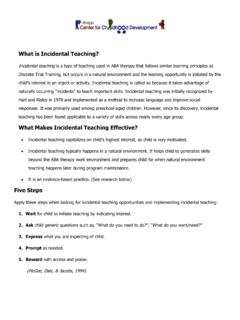Transcription of Exploring Developmentally Appropriate Practice (DAP)
1 As a practitioner caring for children, it is your responsibility to seek out and intentionally plan the best opportunities for children that support their overall well-being and healthy development. The practices that you use when you work with young children need to embrace the most current, effective approaches in learning and development: best practices, thoughtful teaching, quality practices, and Developmentally Appropriate Practices (DAP). DAP comes from a deep history in early education, research, and what many describe as good thinking. NAEYC (National Association for the Education of Young Children), states, Developmentally Appropriate Practice is informed by what we know from theory and literature about how children develop and learn. In its Developmentally Appropriate Practice Key Messages of the Position Statement, NAEYC shares the following in defining DAP: Developmentally Appropriate Practice requires both meeting children where they are which means that teachers must get to know them well and enabling them to reach goals that are both challenging and achievable.
2 All teaching practices should be Appropriate to children s age and developmental status, attuned to them as unique individuals, and responsive to the social and cultural contexts in which they live. Developmentally Appropriate Practice does not mean making things easier for children. Rather, it means ensuring that goals and experiences are suited to their learning and development and challenging enough to promote their progress and interest. Best Practice is based on knowledge not on assumptions of how children learn and develop. The research base yields major principles in human development and learning. Those principles, along with evidence about curriculum and teaching effectiveness, form a solid basis for decision making in early care and education. (This position statement articulates 12 principles.)
3 Developmentally Appropriate Practice is a comprehensive educational perspective that supports optimal healthy development for every child . Developmentally Appropriate Practice embraces both continuity and change; continuity because it guides a tradition of quality early learning and change as it incorporates new research, knowledge, and science in regard to children s development and learning. Exploring Developmentally Appropriate Practice (DAP) child development principles that inform DAP1. All the domains of development are Many aspects of children s learning and development follow well-documented Development and learning proceed at varying rates from child to Development and learning result from a dynamic and continuous interaction of biological maturation and Early experiences have profound effects on a child s development and learning, and there are optimal times for certain learning and development to Development proceeds toward greater complexity, self-regulation, and representational Children develop best when they have secure.
4 Consistent relationships with responsive caregivers and Development and learning occur within and are influenced by social and cultural Children learn in a variety of ways and are actively engaged in Play is a main way that children learn and develop Development and learning occur when children are slightly challenged and through Children s dispositions and behavior are shaped by experiences and affect their learning and : a decision making toolYou, as an early childhood professional who works with young children, are a decision-maker. You make decisions about the children in your program on a daily basis. Understanding DAP its meaning and intentional practices is essential in guiding the decisions you make. Developing the skills to make good decisions for children relies on building knowledge about individual children and child development principles combined with knowledge of effective early learning practices.
5 These are the core considerations in Developmentally Appropriate of individual children and child development principlesDAP is informed by three areas of knowledge that are critical components in making good decisions for child development appropriateness child development follows general, sequential patterns and is interrelated across domains (cognitive, physical, social and emotional). Know and understand milestones and sequences of development in all domains and use child development information for planning and identifying activities, environments, experiences, and strategies (for large/small groups or individuals) to best promote growth and learning. 2. Individual appropriateness each child is an individual and develops in her own, unique way. Know each child s strengths, abilities, needs, challenges, interests, temperament, and approaches to learning.
6 Know their individual skills, ideas and joys. This can be done through time spent together (conversations, etc.), Observation, assessment, work samples, documentation, and information from families and past teachers/programs. 3. Social and cultural appropriateness all children grow within a culture. Know each child s cultural and family background his unique family, values, expectations, language, lifestyles, and beliefs. Show respect for cultures in the experiences you provide; make sure they are meaningful for each child /family. Children interpret everything through their own culture and teachers must consider this, along with overall child development and individual development, in all aspects of the learning program. Knowledge of effective early learning practicesDAP focuses on five key areas of early learning practices: Creating a caring community of learners.
7 Build positive and responsive relationships between children, staff, and families, both among groups and within the program, to create a community that supports all children as they develop and learn to their capacity in all domains. Teaching to enhance development and learning. Provide a balance of teacher-directed and child -initiated activities and plan experiences that meet individual needs, interests, and learning goals. Planning curriculum to achieve important goals. Develop a written curriculum that reflects developmental milestones and Appropriate early learning goals for children and that supports individualized learning. Assessing children s development and learning. Link assessment to curriculum and early learning standards and use authentic assessment methods to measure a child s progress. Establishing reciprocal relationships with families.
8 Work in partnership with families to learn about each child , to develop two-way communication, and to establish supportive relationships with all : Copple, Carol and Sue Bredekamp, editors. Developmentally Appropriate Practice in Early Childhood Programs: Serving Children from Birth through Age 8, 3rd Edition. Washington, DC: National Association for the Education of Young Children, by funds from the Office of child Development and Early Learning, jointly overseen by the Departments of Human Services and publication is available in alternative media on State is an equal opportunity, affirmative action employer, and is committed to providing employment opportunities to minorities, women, veterans, individuals with disabilities, and other protected groups. Nondiscrimination: C. Mincemoyer, , Better Kid Care Program Director 2182 Sandy Drive Suite 204 State College, PA 16803 2016 The Pennsylvania State University
